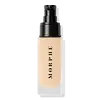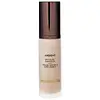What's inside
What's inside
 Key Ingredients
Key Ingredients

 Benefits
Benefits

 Concerns
Concerns

 Ingredients Side-by-side
Ingredients Side-by-side

Water
Skin ConditioningIsohexadecane
EmollientIsododecane
EmollientDimethicone
EmollientCetyl PEG/PPG-10/1 Dimethicone
EmulsifyingTrimethylsiloxysilicate
EmollientButylene Glycol
HumectantC13-15 Alkane
SolventGlycerin
HumectantDimethicone/Vinyl Dimethicone Crosspolymer
Skin ConditioningPEG-10 Dimethicone
Skin ConditioningSodium Chloride
MaskingDisteardimonium Hectorite
StabilisingTriethoxycaprylylsilane
Phenoxyethanol
PreservativeTribehenin
EmollientPolysilicone-11
Sorbitan Sesquioleate
EmulsifyingMaltodextrin
AbsorbentPolymethyl Methacrylate
Punica Granatum Seed Extract
Skin ConditioningPropylene Carbonate
SolventAlpinia Galanga Extract
Skin ConditioningPentylene Glycol
Skin ConditioningTrisodium EDTA
Caprylic/Capric Triglyceride
MaskingXanthan Gum
EmulsifyingSodium Hyaluronate
HumectantCI 77891
Cosmetic ColorantIron Oxides
Water, Isohexadecane, Isododecane, Dimethicone, Cetyl PEG/PPG-10/1 Dimethicone, Trimethylsiloxysilicate, Butylene Glycol, C13-15 Alkane, Glycerin, Dimethicone/Vinyl Dimethicone Crosspolymer, PEG-10 Dimethicone, Sodium Chloride, Disteardimonium Hectorite, Triethoxycaprylylsilane, Phenoxyethanol, Tribehenin, Polysilicone-11, Sorbitan Sesquioleate, Maltodextrin, Polymethyl Methacrylate, Punica Granatum Seed Extract, Propylene Carbonate, Alpinia Galanga Extract, Pentylene Glycol, Trisodium EDTA, Caprylic/Capric Triglyceride, Xanthan Gum, Sodium Hyaluronate, CI 77891, Iron Oxides
Water
Skin ConditioningCyclopentasiloxane
EmollientCyclohexasiloxane
EmollientIsododecane
EmollientTrimethylsiloxysilicate
EmollientGlycerin
HumectantButylene Glycol
HumectantDimethicone
EmollientLauryl PEG-10 Tris(Trimethylsiloxy)Silylethyl Dimethicone
EmulsifyingPolymethylsilsesquioxane
1,2-Hexanediol
Skin ConditioningDisteardimonium Hectorite
StabilisingAcrylates/Polytrimethylsiloxymethacrylate Copolymer
Skin ConditioningMagnesium Sulfate
Sorbitan Sesquioleate
EmulsifyingDimethicone/Vinyl Dimethicone Crosspolymer
Skin ConditioningTriethoxycaprylylsilane
Dimethicone/PEG-10/15 Crosspolymer
Aluminum Hydroxide
EmollientTribehenin
EmollientCaprylyl Glycol
EmollientTocopheryl Acetate
AntioxidantEthylhexylglycerin
Skin ConditioningXanthan Gum
EmulsifyingCaesalpinia Spinosa Fruit Extract
Skin ProtectingDipropylene Glycol
HumectantSodium Citrate
BufferingKappaphycus Alvarezii Extract
Skin ConditioningTocopherol
AntioxidantCamellia Sinensis Leaf Extract
AntimicrobialCI 77891
Cosmetic ColorantIron Oxides
Water, Cyclopentasiloxane, Cyclohexasiloxane, Isododecane, Trimethylsiloxysilicate, Glycerin, Butylene Glycol, Dimethicone, Lauryl PEG-10 Tris(Trimethylsiloxy)Silylethyl Dimethicone, Polymethylsilsesquioxane, 1,2-Hexanediol, Disteardimonium Hectorite, Acrylates/Polytrimethylsiloxymethacrylate Copolymer, Magnesium Sulfate, Sorbitan Sesquioleate, Dimethicone/Vinyl Dimethicone Crosspolymer, Triethoxycaprylylsilane, Dimethicone/PEG-10/15 Crosspolymer, Aluminum Hydroxide, Tribehenin, Caprylyl Glycol, Tocopheryl Acetate, Ethylhexylglycerin, Xanthan Gum, Caesalpinia Spinosa Fruit Extract, Dipropylene Glycol, Sodium Citrate, Kappaphycus Alvarezii Extract, Tocopherol, Camellia Sinensis Leaf Extract, CI 77891, Iron Oxides
 Reviews
Reviews

Ingredients Explained
These ingredients are found in both products.
Ingredients higher up in an ingredient list are typically present in a larger amount.
Butylene Glycol (or BG) is used within cosmetic products for a few different reasons:
Overall, Butylene Glycol is a safe and well-rounded ingredient that works well with other ingredients.
Though this ingredient works well with most skin types, some people with sensitive skin may experience a reaction such as allergic rashes, closed comedones, or itchiness.
Learn more about Butylene GlycolCi 77891 is a white pigment from Titanium dioxide. It is naturally found in minerals such as rutile and ilmenite.
It's main function is to add a white color to cosmetics. It can also be mixed with other colors to create different shades.
Ci 77891 is commonly found in sunscreens due to its ability to block UV rays.
Learn more about CI 77891Dimethicone is a type of synthetic silicone created from natural materials such as quartz.
What it does:
Dimethicone comes in different viscosities:
Depending on the viscosity, dimethicone has different properties.
Ingredients lists don't always show which type is used, so we recommend reaching out to the brand if you have questions about the viscosity.
This ingredient is unlikely to cause irritation because it does not get absorbed into skin. However, people with silicone allergies should be careful about using this ingredient.
Note: Dimethicone may contribute to pilling. This is because it is not oil or water soluble, so pilling may occur when layered with products. When mixed with heavy oils in a formula, the outcome is also quite greasy.
Learn more about DimethiconeThis ingredient is a silicone used to improve the texture of products and absorb oil. It does not get absorbed into the skin.
Like other silicones, Dimethicone/Vinyl Dimethicone Crosspolymer helps condition the skin by creating a barrier. In this sense, it can act as an emollient and trap moisture in.
This ingredient is a type of elastomer.
Learn more about Dimethicone/Vinyl Dimethicone CrosspolymerDisteardimonium Hectorite comes from the clay mineral named hectorite. It is used to add thickness to a product.
It can also help stabilize a product by helping to disperse other ingredients.
Hectorite is a rare, white clay mineral.
Learn more about Disteardimonium HectoriteGlycerin is already naturally found in your skin. It helps moisturize and protect your skin.
A study from 2016 found glycerin to be more effective as a humectant than AHAs and hyaluronic acid.
As a humectant, it helps the skin stay hydrated by pulling moisture to your skin. The low molecular weight of glycerin allows it to pull moisture into the deeper layers of your skin.
Hydrated skin improves your skin barrier; Your skin barrier helps protect against irritants and bacteria.
Glycerin has also been found to have antimicrobial and antiviral properties. Due to these properties, glycerin is often used in wound and burn treatments.
In cosmetics, glycerin is usually derived from plants such as soybean or palm. However, it can also be sourced from animals, such as tallow or animal fat.
This ingredient is organic, colorless, odorless, and non-toxic.
Glycerin is the name for this ingredient in American English. British English uses Glycerol/Glycerine.
Learn more about GlycerinIsododecane is a fragrance, emollient, and solvent.
As an emollient, it helps your skin stay soft and hydrated. Emollients help trap moisture into your skin.
Isododecane's role as a solvent makes it a great texture enhancer. It spreads smoothly on skin and does not leave a sticky feeling behind. Isododecane also helps prevent color transfer in makeup products.
Isododecane is not absorbed into skin.
Learn more about IsododecaneSorbitan Sesquioleate is derived from sorbitol and oleic acid. It is an emulsifier and prevents ingredients from separating.
Specifically, this ingredient is a water-in-oil emulsifier, meaning it helps water dissolve into oil.
Some studies suggest this ingredient may cause irritation in some people. If you are unsure, it is best to patch test.
This ingredient may not be Malassezia folliculitis, or fungal-acne safe.
Learn more about Sorbitan SesquioleateTribehenin comes from glycerin and behenic acid.
It is used as an emollient, or moisturizer. Emollients form a thin barrier on skin to prevent moisture from escaping.
This ingredient may not be Malassezia folliculitis, or fungal-acne safe.
Learn more about TribeheninTriethoxycaprylylsilane is a silicone used to bind and stabilize ingredients.
As an emulsifier, it helps prevent ingredients from separating. This can help elongate the shelf life of products.
Triethoxycaprylylsilane is often used to coat mineral sunscreens ingredients to help give a better feel. It also helps reduce oxidative stress in sunscreens.
Learn more about TriethoxycaprylylsilaneThis silicone is an emollient. Emollients create a thin film on the skin to prevent moisture from escaping.
It is not soluble in water and helps increase water-resistance in products.
According to a manufacturer, it can blend seamlessly with silicone oils, such as Cyclopentasiloxane.
Learn more about TrimethylsiloxysilicateWater. It's the most common cosmetic ingredient of all. You'll usually see it at the top of ingredient lists, meaning that it makes up the largest part of the product.
So why is it so popular? Water most often acts as a solvent - this means that it helps dissolve other ingredients into the formulation.
You'll also recognize water as that liquid we all need to stay alive. If you see this, drink a glass of water. Stay hydrated!
Learn more about WaterXanthan gum is used as a stabilizer and thickener within cosmetic products. It helps give products a sticky, thick feeling - preventing them from being too runny.
On the technical side of things, xanthan gum is a polysaccharide - a combination consisting of multiple sugar molecules bonded together.
Xanthan gum is a pretty common and great ingredient. It is a natural, non-toxic, non-irritating ingredient that is also commonly used in food products.
Learn more about Xanthan GumThis ingredient is a combination of red, black, and yellow iron oxide pigments. This combination of colors is usually found in foundation, because it results in a "skin" color.